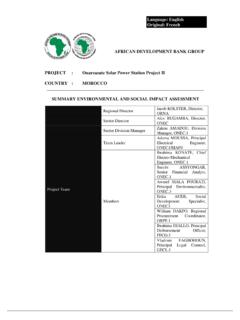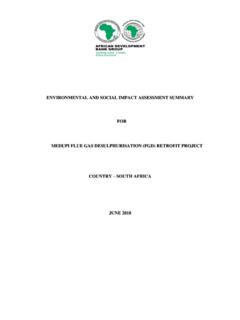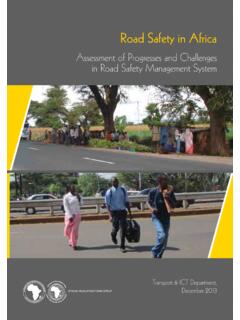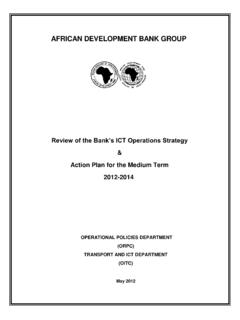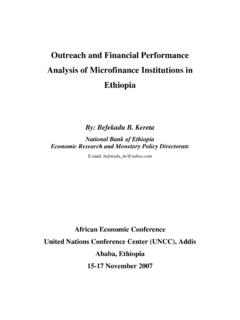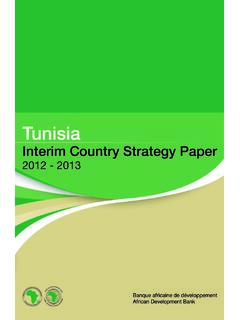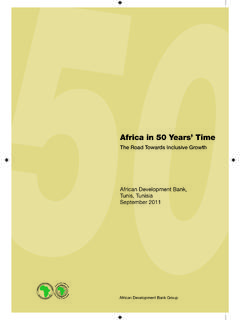Transcription of CHAPTER 7: Water Resource Management, Supply and …
1 CHAPTER 7: Water Resource Management, Supply and Sanitation THE SETTING sector. The result was a large scale mobilization of humanitarian assistance by the international Zimbabwe is a semi-arid country heavily community to help the country address the reliant on regular rains (generally November immediate risks posed by the cholera outbreak to April). Mean annual rainfall is low and and to support the rehabilitation of Water many rivers in the drier parts of the country are Supply and sanitation services in urban and not perennial. Zimbabwe has made extensive rural areas. As a result, the number of cases investments in large, small, and medium dams, reported in 2009-10 declined substantially. The though current utilization is only about 22 challenge for the decade ahead is to rebuild the percent of mean annual run-off. Zimbabwe's existing dilapidated infrastructure and access management of its Water resources is critical to to services to the levels that prevailed more its economic growth.
2 Droughts and inability to than a decade ago. manage its Water resources cost Zimbabwe a signi cant percentage of its GDP. The country CURRENT POLICY. has a forward-looking Water Act and undertook AND INSTITUTIONAL. signi cant reforms in the 1990s to create a Zimbabwe National Water Authority (ZINWA) FRAMEWORK. to manage the national Water resources. But the Water Resource sector has been badly hit Policy Framework for by the economic downturn and the lack of Water and Sanitation investment has nulli ed many of the reform There is no one document that provides a gains. Rivers are now unregulated, inadequate policy framework for the management of attention has been given to the maintenance the country's Water resources, and for the of key Water Resource infrastructure with a provision of Water and sanitation services. high risk to public safety from the breach of The Water Act of 1998 reformed the Water dams, catchment plans are not implemented, sector to ensure a more equitable distribution and signi cant pollution has occurred in some of Water and a stakeholder involvement in the major Water bodies.
3 Management of Water resources. Water was In the 1980s, Zimbabwe launched an no longer privately owned. The prior system ambitious program of development of its Water of Water rights was replaced by Water permits Supply and sanitation infrastructure; by the later of limited duration which are allocated by part of the 1990s the levels of service coverage Catchment Councils. Water was to be treated were among the highest in Sub-Saharan Africa. as an economic good and the principle of user The country was widely seen, within Africa pays was to apply. Pollution of Water became and internationally, as a leader in innovation, an offence under the new Act which adopted policy reform, and service provision in the the principle of polluter pays.. Water sector. However, the fortunes of the The Zimbabwe National Water Authority sector were reversed in the past decade as Act of 1998 led to the creation of ZINWA, a result of very limited new investment in a parastatal agency responsible for Water services and inadequate revenues of the planning and bulk Supply .
4 ZINWA was to institutions responsible for service provision manage Water resources on a catchment basis that led to a sustained decline in operations and with involvement of stakeholders in each maintenance of assets. The progressive decline catchment area. Other responsibilities of in Water and sewerage services culminated in a ZINWA included the management of the Water serious outbreak of cholera in the 2008/09 rainy permit system, the pricing of Water , operating season. With almost 100,000 cases of cholera and maintaining existing infrastructure, and and about 4,280 deaths, international attention executing development projects. ZINWA was was drawn to the extent of the decline in the Water Resource Management, Supply and Sanitation Zimbabwe Report 1. to devolve responsibility for managing river program. The land redistribution program systems and enforcing laws and regulations at has resulted in an increase in the land under the local level.
5 Irrigation that is operated by smallholders as The Land Acquisition Act of 2000 a result of commercial irrigated farms being empowered the government to acquire any land acquired and subdivided into smaller parcels for resettlement purposes under the land reform of farm land. The Environmental Management Act related to management and conservation of the 2002 provides for the establishment of environment . the National Environmental Council, the The Act empowered the Government to Environmental Management Agency, command public and private development environment Management Board, and the institutions to undertake an Environmental Standards and Enforcement Committee. Impact Assessment (EIA) before undertaking The environment Fund, provides for the any activity and adhere to mitigating activities formulation of environmental quality standards to protect the environment as recommended in and environmental plans, provides for the EIA.
6 Irrigation development is one of the environmental impact assessments, audit, and activities that require an EIA. monitoring of projects, and for other matters 2 Zimbabwe Report Water Resource Management, Supply and Sanitation Institutional Arrangements Management of Water Resources for the Sector Figure sets out the organizational The institutions of the Water and sanitation arrangements for the principle institutions sector are organized by law and policy with responsibilities for the management according to their responsibilities for service of Water resources in Zimbabwe. These provision. There are four distinct areas of arrangements stem from the Water Act of 1998. service and related institutional arrangements: and the Zimbabwe National Water Authority (i) Water resources management; (ii) urban (ZINWA) Act of 1998. For the purposes Water Supply and sanitation; (iii) rural Water of managing the nation's Water resources, Supply and sanitation; and (iv) irrigation.
7 The Zimbabwe is divided into seven catchments detailed arrangements for each of these service that are based on the six major river basins in areas are set out below. the country. Each catchment is administered by Water Resource Management, Supply and Sanitation Zimbabwe Report 3. an elected catchments council, with technical (MWRDM) provides guidance on policy support from ZINWA. The Minister for Water matters through the Department of Water Resources Development and Management Resources (DWR). 4 Zimbabwe Report Water Resource Management, Supply and Sanitation The Department of Water Resources assists the To effect the joint management of ministry to carry out the following statutory international Water resources, as directed functions: by the Minister. Development of Water policies, laws and The head of ce of ZINWA is located in Harare regulations and general directions to guide and it has a branch of ce in each of the seven the orderly and integrated planning of the catchments headed by a Catchment Manager.
8 Nation's Water resources to ensure their The multidisciplinary staff of the latter is optimum development, utilization and responsible for the statutory functions of protection; ZINWA. The staff typically includes expertise in hydrology, hydrogeology, Water Supply and Ensuring the availability of Water to all quality, and administrative support. citizens for the primary purposes with due regard to environmental requirements; Each Catchment Council (CC) is established by a statutory instrument under the Water Act. Ensuring the equitable and ef cient The councils are composed of representatives allocation of available Water to all users; of those sub-catchment councils in each Giving effect to any international Water catchment. The Catchment Manager's of ce agreements to which Zimbabwe is party; provides technical and secretarial services to the respective catchment councils. The main Fixing the criteria for Water allocation and responsibilities of each council are: (i) to the issue of permits by Catchment Councils.
9 Prepare a Catchment Outline Plan (COP) for its The main responsibilities of the Zimbabwe river system; (ii) to determine and grant Water National Water Authority (ZINWA) are as use permits under criteria set by the Department follows: of Water Resources (DWR); (iii) to regulate To advise the Minister on the formulation and supervise the exercise of rights to, and use of national Water policies and standards; of Water in respect of its river system; and (iv). to ensure proper compliance with the Act and To exploit, manage, and conserve Water to supervise sub-catchment councils. resources in order to ensure security of Supply and to facilitate equitable access The sub-catchment councils (SCC). to Water by all sectors, and its ef cient are established by the Minister through a utilization, while minimizing the impacts statutory instrument under the Water Act for of drought, oods and other hazards; any part of a declared river system that falls under the catchment council.
10 The SCC is the To provide specialist advice and technical operational arm of the CC. Its main function assistance to local authorities and is to regulate and supervise the exercise of catchment councils in matters concerning rights to Water within the area for which it the development, management and was established. It also performs any other environmental protection of Water resources; functions that may be conferred upon it in To provide design and construction services terms of the Water Act. for new works and to operate and maintain The stakeholders comprise the Water users, Water Supply facilities owned or managed members of government departments with by ZINWA; legal responsibilities in the management of To carry out and publish hydrological natural resources, and private organizations and geographical surveys, including that represent interests in the basin or otherwise Water related research, for the purposes of have a direct stake in Water management planning, development, and exploitation of in the catchment.
